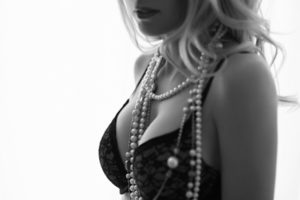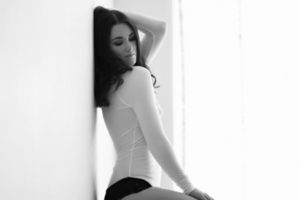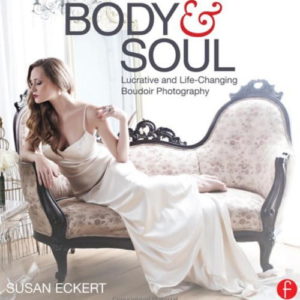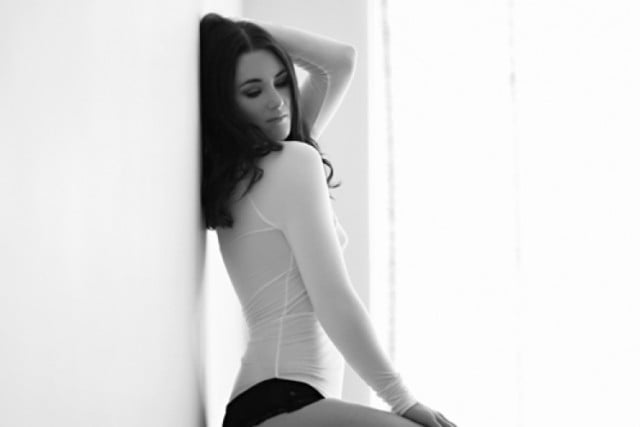 Susan Eckert is an internationally published photographer, a career-long member of PPA, and a member of WPPI and AIBP. Prior to becoming a boudoir photographer, Susan earned a master’s degree in psychology from Columbia University. She is the author of Body and Soul: Lucrative and Life-Changing Boudoir Photography.
Susan Eckert is an internationally published photographer, a career-long member of PPA, and a member of WPPI and AIBP. Prior to becoming a boudoir photographer, Susan earned a master’s degree in psychology from Columbia University. She is the author of Body and Soul: Lucrative and Life-Changing Boudoir Photography.
When it comes to sexy photography, there is a line between tasteful and NSFW. In the boudoir photography genre, one that stems from the early 1900s, it’s more about the former, capturing images that don’t necessarily have to show any skin. In fact, a subject in a boudoir photo could be fully clothed; contrary to what you might think, boudoir photography isn’t just about baring it all. Think of it as the slightly edgier side of portrait photography.
If you’re looking for something to do with your loved one this Valentine’s Day, that doesn’t involve overpriced dinners, step behind the camera and capture what she or he finds beautiful about  themselves (boudoir images are typically of women, but it’s the 21st-century, you make the rules). The resulting photograph is a far more thoughtful, everlasting gift than dead flowers. (How much clothing stays on or off is entirely up to your subject.)
themselves (boudoir images are typically of women, but it’s the 21st-century, you make the rules). The resulting photograph is a far more thoughtful, everlasting gift than dead flowers. (How much clothing stays on or off is entirely up to your subject.)
For some tips on shooting your own boudoir-style photos at home, we reached out to photographer Susan Eckert, an expert in boudoir photography and the author of the recently released book, Body and Soul: Lucrative and Life-Changing Boudoir Photography (Focal Press). What makes Eckert’s work in the medium successful is her understanding of human emotions, thanks to her background as a former psychologist.
“Over the years, I’ve heard my fair share of DIY boudoir photography horror stories,” Eckert says. “’He just loves taking pics of me,’ a woman will tell me, ‘but when I look at the images, they’re just sooooo unflattering, so I make him delete them!”
Eckert says that while nearly everyone has a camera in his/her pocket these days (thanks, iPhone!), there’s a difference between amateur and professional, and it all has to do with know-how.
“Professional photographers learn to see light in a way that others haven’t yet trained themselves to do,” Eckert says. “We also notice lines and shapes in a way that others may not. Our training gives us valuable information that helps us to understand why something is flattering or unflattering. We understand why certain lenses create distortion, and which focal distances make for flattering images when shooting headshots, 3/4 shots, or full-length images. Boudoir photographers learn how to create images that emphasize what a woman loves about her body while playing down what she doesn’t.”
Here are seven pro tips Eckert offers for setting up a boudoir photo studio.
Boudoir photographers learn how to create images that emphasize what a woman loves about her body while playing down what she doesn’t.
Shoot from her perspective, not yours. What does she like about her body? What makes her self-conscious? Compose your images and position her so her best assets are highlighted while the things that make her self-conscious fall into the background. Don’t know what she loves about her body? Engage her in a discussion about it beforehand – tell her what you love about her body and then more importantly, encourage her to share her thoughts with you.
Evoke emotion. How would you describe her? Is she playful? Edgy? Sexy? Shy? Talk to her as you capture images – say things that will evoke the emotions you wish to capture. Know that she’ll feel silly with a camera trained on her, so allow her to look away and guide her in real actions, like brushing hair away from her face. Be sure to guide her in moving at a speed your camera will be able to capture without blur. If you’re using a DSLR, modify your speed settings accordingly (shoot manual or shutter priority). Share encouraging words throughout and you’ll build her self-esteem in the process.

Susan Eckert is an internationally published photographer, a career-long member of PPA, and a member of WPPI and AIBP. Prior to becoming a boudoir photographer, Susan earned a master’s degree in psychology from Columbia University. She is the author of Body and Soul: Lucrative and Life-Changing Boudoir Photography.
Look for the light. Most often, light is the main culprit behind unflattering images. Ask yourself: Where is the light falling and accordingly, where are the shadows? Overhead light creates ugly shadows beneath the eyes, while light coming from directly below creates a ghastly haunted look. Consistently pay attention to the light – its direction, color and source. Fluorescent light is just about as unflattering as you can get, while soft diffused window light flatters skin like nothing else can.
Watch for distortions. As a general rule, whatever is closer to the camera will look larger. This is especially so when you’re using a wide-angle lens. Position her in diagonals to minimize and flatter.
Use arms and legs to create interest in an image. Lingerie models are adept at making beautiful triangles and shapes with arms and legs. Study the positioning of arms and legs on a lingerie site and you’ll see what I mean.
Vary your shots so you get a nice variety. Shoot close-ups that honor her favorite features, as well as full length and 3/4 shots (from head to the knee, or 75-percent of the body).
Bonus: Hand-pick something flattering to wear. If she feels sexy, she’ll be sexy! But remember, it’s what she finds comfortable.


The list is perfect for me, as my newborn’s photosession is just some days away!
Marvellous tips! The bullet-point list is just awesome!
Marvellous tips! The bullet-point list is just awesome!